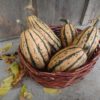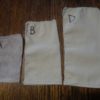Styrian pumpkin
Price range: $4.00 through $7.00
(Cucurbita pepo)
This pumpkin is unique: it is grown for its seeds, which are “hulless;” that is, they lack a seed coat, making them easy and delightful to eat. Hullessness is rare; all hulless pumpkins are believed to be descendants of one plant, which was found by an observant farmer in the Steiermark (Styria) region of Austria sometime around 1870. Originally selected for pressing for vegetable oil, hulless pumpkin seeds are now a popular snack. Unfortunately there is a tradeoff: while the seeds are excellent, the flesh of the pumpkin is rather bland and stringy (we feed it to our chickens, who love pumpkin). We are still looking for a hulless pumpkin variety which is also a good winter squash.
Note for seed savers: Unfortunately we had a crop failure with this squash. We transplanted them out after we thought we were safely past frost, only to have a sneaky late frost kill all but five of them. The plants recovered and still produced good fruit, so the seed is perfectly fine; but it will give a genetic bottleneck effect, and so it is not ideal for saving seed.
120 days to maturity; 20 seeds/packet.
Start indoors 3-4 weeks before last frost, with 1-2 seeds per pot 1/2” deep and thinned to strongest plant. Can also direct seed after frost in late May- early June. Plant three plants per hill, 6-8’ apart. Topdress with manure. If planting with corn and beans, plant in separate hills between rows of corn hills at same time as corn. Before frost, harvest squash, leaving a stub of stem several inches long; cure indoors for several weeks to a month, then remove seeds and dry them. Store at room temperature.




